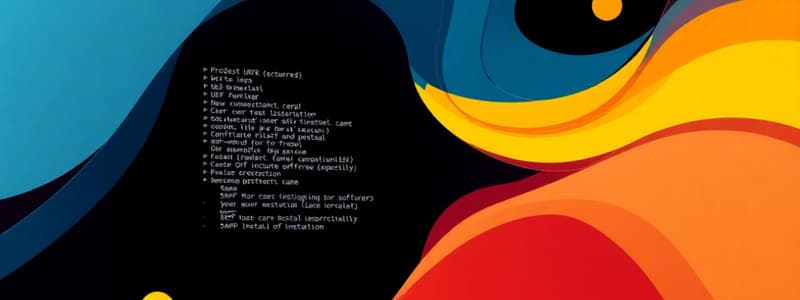Podcast
Questions and Answers
What are the two basic types of software?
What are the two basic types of software?
Application software and system software.
Name two ways software can be distributed.
Name two ways software can be distributed.
Local installation and Software as a Service (SaaS).
What is one characteristic of proprietary software?
What is one characteristic of proprietary software?
It is commercial and not freely available to modify.
What happens during a full installation of software?
What happens during a full installation of software?
What is one important tip for designing effective presentations?
What is one important tip for designing effective presentations?
Describe the structure of a database.
Describe the structure of a database.
Describe two main functions of the CPU.
Describe two main functions of the CPU.
What are the major components of the CPU's machine cycle?
What are the major components of the CPU's machine cycle?
What are two major types of storage drives, and how do they differ?
What are two major types of storage drives, and how do they differ?
What is unique about Linux as an operating system?
What is unique about Linux as an operating system?
What distinguishes a multiuser operating system from a single-user operating system?
What distinguishes a multiuser operating system from a single-user operating system?
Name three popular operating systems for personal computers.
Name three popular operating systems for personal computers.
Flashcards are hidden until you start studying
Study Notes
Software Basics
- Software is a set of instructions telling computers what to do.
- There are two main types of software: application software and system software.
Distributing Software
- Software can be developed as proprietary (commercial) or open-source (free).
- Software can be distributed through local installation, Software as a Service (SaaS), or subscription.
Purchasing Software
- Software can be purchased from brick and mortar stores, downloaded from the Internet, or obtained through student discounts.
- Freeware is software available for free, while beta versions are pre-release versions of software for testing.
Installing and Uninstalling Software
- System requirements specify the minimum hardware and software needed for software to run properly.
- A restore point allows you to revert your system to a previous state.
- Software can be installed through full installation, which installs all components, or custom installation, which allows you to choose specific components.
- Recovering from a computer crash might involve using a recovery drive to reinstall the operating system.
- Uninstalling software removes it from your computer.
Upgrading Software
- Subscription or SaaS software typically receives automatic updates, eliminating the need for manual upgrades.
- Upgrading software can improve performance and security, but it can also be costly.
- Software updates are typically smaller than upgrades and address specific issues.
Software Licenses
- End User License Agreement (EULA) outlines key aspects of software use, such as ownership, allowed copies, installation limits, and warranties.
- Copyleft licenses encourage software sharing and modification.
Productivity and Business Software
- Productivity software aids in various tasks at home, school, and work.
- Popular proprietary options include Microsoft Office and Apple iWork, while open-source options include LibreOffice.
- Web-based productivity suites offer features like Microsoft Office Online, Google Docs, Zoho, and ThinkFree.
Word Processing
- Word processing software creates and edits documents.
- Examples include Microsoft Word and LibreOffice Writer.
Spreadsheet
- Spreadsheet software performs calculations and numerical analyses.
- Data types include text, values and dates, formulas, and functions.
- Popular examples include Microsoft Excel and LibreOffice Calc.
Presentation Software
- Presentation software helps create visual aids and presentations.
- Effective presentation design incorporates images, careful color choices, bullet points for key points, appropriate font size and style, and minimal animation and background audio.
Database Software
- Database software stores and organizes data.
- It uses fields, records, and tables to structure information.
Note-taking Software
- Note-taking software helps capture and organize notes.
- Examples include OneNote and Evernote.
Personal Information Manager (PIM)
- PIMs manage email, contacts, calendars, and tasks.
- Popular options include Outlook and web-based PIMs like Yahoo! and Google.
- Other PIM options include Toodledo and OmniFocus.
Productivity Software Features
- Wizards guide users through steps for completing tasks.
- Templates are predesigned forms that can be customized.
- Macros are small programs that group a series of commands.
Operating System Fundamentals
- An operating system (OS) manages the computer's hardware and software.
- Utility programs are tools that perform specific tasks, like disk cleanup or file recovery.
- The operating system functions include managing hardware, allowing application software to interact with the CPU, and managing, scheduling, and coordinating tasks.
User Interface
- The user interface is how users interact with the computer.
- Common elements include desktops, icons, and menus.
- Operating systems can be single-user or multi-user, and single-task or multi-task.
Operating Systems for Personal Use
- The top three operating systems for personal computers are Windows, macOS, and Linux.
- Mobile operating systems include Android, iOS, and Windows.
- Web-based operating systems include Google Chrome OS.
Linux
- Linux is an open-source operating system used for personal computers, web servers, and other applications.
- Distributions (distros) are specific variations of the Linux operating system.
- Upgrading the OS should be considered based on system needs and compatibility.
Operating Systems for Machinery, Networks, and Business
- Real-time operating systems (RTOS) manage machines that perform repetitive tasks with precise timing.
- Multiuser operating systems, like Unix, allow several users to access the computer simultaneously.
Moore's Law
- Moore's Law describes the exponential increase in computing power over time.
- When evaluating hardware, consider factors like speed, Moore's Law, and system components such as DRAM and hard drives.
Selecting a Computing Device
- A wide range of computing devices are available, including smartphones, tablets, ultrabooks, 2-in-1s, laptops, and desktops.
How the CPU Works
- The CPU (Central Processing Unit) is located on the motherboard and processes instructions, performs calculations, and manages information flow.
- Intel and AMD are leading CPU manufacturers.
- The machine cycle involves four stages: fetch, decode, execute, and store.
- The CPU consists of two units: the control unit and the arithmetic logic unit (ALU).
Storage Needs
- Storage needs vary based on the type and size of the data you need to store.
- Redundant array of independent disks (RAID) provides data protection and redundancy through combining multiple disks.
- RAID 0 increases performance but doesn't provide fault tolerance.
- RAID 1 mirrors data across multiple disks, offering redundancy but slower performance.
Video Cards
- Video cards are crucial for displays and graphics processing.
- Ports like HDMI, DVI, and DisplayPort provide connections between the video card and monitor.
- Video memory stores graphics data.
- Screen resolution determines the sharpness and detail of the display.
- GPUs (Graphics Processing Units) handle graphics processing, improving performance for games and graphics-intensive applications.
Sound Cards
- Sound cards handle audio output, enabling your computer to produce sound.
- Features like 3D sound technology, surround sound, and Dolby Digital 7.1 enhance audio quality.
- A MIDI interface allows music instruments and devices to connect to the computer.
Maintaining System Reliability
- Enhance system reliability by installing antivirus programs, spyware and adware protection, regularly clearing unnecessary files, running Disk Defragmenter, and automating essential utilities.
- In case of system crashes, try System Restore, check RAM availability, investigate error codes using Google, and consider a Windows Reset.
Getting Rid of Your Old Computer
- Recycling, donating, or disposing of old computers should be done responsibly.
- Before disposing of a computer, erase sensitive data and remove hard drives.
- Consider donating working computers to charities or schools.
- Recycling options are available for old computers.
Studying That Suits You
Use AI to generate personalized quizzes and flashcards to suit your learning preferences.




